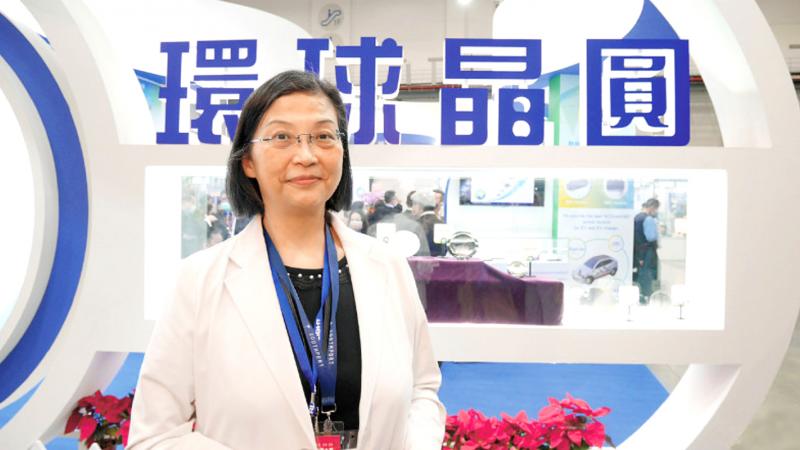GlobalWafers Co (環球晶圓) yesterday unveiled a new capacity expansion plan worth NT$100 billion (US$3.59 billion) as part of its effort to boost capacity and satisfy strong customer demand after its takeover of Germany’s Siltronic AG failed last week.
The world’s third-largest silicon wafer supplier expects the expansion plan to support its revenue growth over the next few years.
This year, revenue could grow by a double-digit percentage on an annual basis as raw wafer demand remains “quite good,” even with some special wafers in short supply, GlobalWafers said.

Photo: Fang Wei-jie, Taipei Times
“While the failed completion of our offer for Siltronic is disappointing, we have pursued a dual-track strategy from the beginning of the tender offer,” GlobalWafers chairwoman and CEO Doris Hsu (徐秀蘭) said during a teleconference yesterday. “I am excited that we can now consider a broad range of options to advance technological development and enhance our capacities.”
The new capacity expansion plan consists of two parts — a new 300mm fab, or green field investments of US$2 billion, and brown field investments of US$1.6 billion on capacity expansion of factories in multiple sites throughout Asia, the US and Europe, Hsu said.
If the Siltronic deal had been given the green light, “our green field investments would be different in scale compared with our previous calculations,” she said.
GlobalWafers dismissed some investors’ concerns about possible oversupply in 2024, saying that new green energy investments worldwide would alleviate supply tightness as raw wafer demand continues to grow on the emergence of new applications.
“The fundamentals did not change at all during the past three months. It is very healthy, although some demand might dip a bit this year,” Hsu said. “Supply continues to be tight.”
“The planned new capacity is mostly for wafers in severe shortage,” she said. “I believe GlobalWafers will continue to be buoyed by the latest capacity expansion.”
Surges in manufacturing costs — in transportation, electricity, raw materials and labor — pose the greatest challenges for the company, Hsu said.
GlobalWafers plans to ramp up production in the new fab in 2024, along with adding capacity from existing factories in the second half of next year.
The company plans to expand capacity for polished wafers, epitaxial wafers, silicon-on-insulator wafers, float-zone wafers, silicon carbide wafers, gallium nitride-on-silicon wafers and other large next-generation products.
The failed Siltronic purchase would not be a barrier to other potential merger and acquisition targets, Hsu said.
However, the company is facing greater challenges in dealmaking, given GlobalWafers’ rising market share amid geopolitical tensions, she said.

SEEKING CLARITY: Washington should not adopt measures that create uncertainties for ‘existing semiconductor investments,’ TSMC said referring to its US$165 billion in the US Taiwan Semiconductor Manufacturing Co (TSMC, 台積電) told the US that any future tariffs on Taiwanese semiconductors could reduce demand for chips and derail its pledge to increase its investment in Arizona. “New import restrictions could jeopardize current US leadership in the competitive technology industry and create uncertainties for many committed semiconductor capital projects in the US, including TSMC Arizona’s significant investment plan in Phoenix,” the chipmaker wrote in a letter to the US Department of Commerce. TSMC issued the warning in response to a solicitation for comments by the department on a possible tariff on semiconductor imports by US President Donald Trump’s

The government has launched a three-pronged strategy to attract local and international talent, aiming to position Taiwan as a new global hub following Nvidia Corp’s announcement that it has chosen Taipei as the site of its Taiwan headquarters. Nvidia cofounder and CEO Jensen Huang (黃仁勳) on Monday last week announced during his keynote speech at the Computex trade show in Taipei that the Nvidia Constellation, the company’s planned Taiwan headquarters, would be located in the Beitou-Shilin Technology Park (北投士林科技園區) in Taipei. Huang’s decision to establish a base in Taiwan is “primarily due to Taiwan’s talent pool and its strength in the semiconductor

An earnings report from semiconductor giant and artificial intelligence (AI) bellwether Nvidia Corp takes center stage for Wall Street this week, as stocks hit a speed bump of worries over US federal deficits driving up Treasury yields. US equities pulled back last week after a torrid rally, as investors turned their attention to tax and spending legislation poised to swell the US government’s US$36 trillion in debt. Long-dated US Treasury yields rose amid the fiscal worries, with the 30-year yield topping 5 percent and hitting its highest level since late 2023. Stocks were dealt another blow on Friday when US President Donald

UNCERTAINTY: Investors remain worried that trade negotiations with Washington could go poorly, given Trump’s inconsistency on tariffs in his second term, experts said The consumer confidence index this month fell for a ninth consecutive month to its lowest level in 13 months, as global trade uncertainties and tariff risks cloud Taiwan’s economic outlook, a survey released yesterday by National Central University found. The biggest decline came from the timing for stock investments, which plunged 11.82 points to 26.82, underscoring bleak investor confidence, it said. “Although the TAIEX reclaimed the 21,000-point mark after the US and China agreed to bury the hatchet for 90 days, investors remain worried that the situation would turn sour later,” said Dachrahn Wu (吳大任), director of the university’s Research Center for